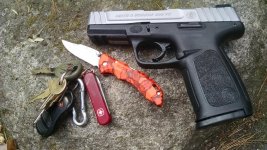Protected One
Member
I came across an interesting topic for discussion while browsing the latest American Handgunner Magazine. The topic was where to index your trigger finger on a drawn semi-auto handgun.
The commonly accepted position is "high along the slide" of the gun, but Mas Ayoob has a different take. (see photo attached)
Being that it seems we've been light on good subjects to discuss, I though I'd throw this one out there.
What are your thoughts on Mas's position and what do you see as pros and cons of each?
The commonly accepted position is "high along the slide" of the gun, but Mas Ayoob has a different take. (see photo attached)
Being that it seems we've been light on good subjects to discuss, I though I'd throw this one out there.
What are your thoughts on Mas's position and what do you see as pros and cons of each?


